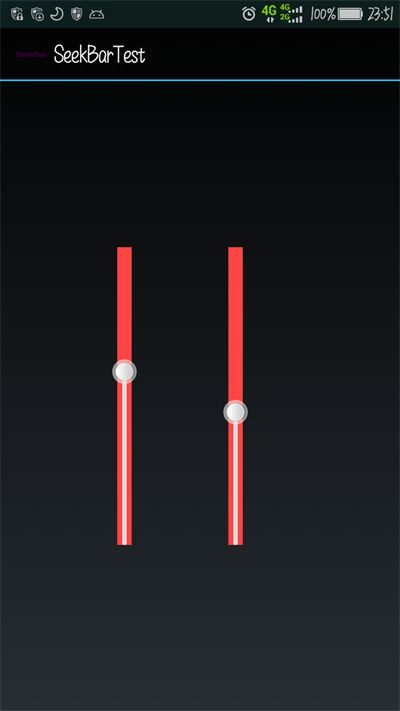垂直进度条VerticalSeekBar
水平的进度条见多了,总会想见个垂直的进度条开开眼。今天咱就试试。
要说原理也简单,就是把宽高倒置,其他的理论上都不需要动,发现问题再补补也就行了。
官方提供
官方是提供了垂直进度条的例子源码的,位置在android-sdk-windows\sources\android-23\com\android\example\rscamera\VerticalSeekBar.java,当然首先你SDK中要有Android 6.0。
VerticalSeekBar.java
/**
* Class to create a vertical slider
*/
public class VerticalSeekBar extends SeekBar {
public VerticalSeekBar(Context context) {
super(context);
}
public VerticalSeekBar(Context context, AttributeSet attrs, int defStyle) {
super(context, attrs, defStyle);
}
public VerticalSeekBar(Context context, AttributeSet attrs) {
super(context, attrs);
}
protected void onSizeChanged(int w, int h, int oldw, int oldh) {
super.onSizeChanged(h, w, oldh, oldw);
}
@Override
protected synchronized void onMeasure(int widthMeasureSpec, int heightMeasureSpec) {
super.onMeasure(heightMeasureSpec, widthMeasureSpec);
setMeasuredDimension(getMeasuredHeight(), getMeasuredWidth());
}
protected void onDraw(Canvas c) {
c.rotate(-90);
c.translate(-getHeight(), 0);
super.onDraw(c);
}
@Override
public boolean onTouchEvent(MotionEvent event) {
if (!isEnabled()) {
return false;
}
switch (event.getAction()) {
case MotionEvent.ACTION_DOWN:
case MotionEvent.ACTION_MOVE:
case MotionEvent.ACTION_UP:
setProgress(getMax() - (int) (getMax() * event.getY() / getHeight()));
onSizeChanged(getWidth(), getHeight(), 0, 0);
break;
case MotionEvent.ACTION_CANCEL:
break;
}
return true;
}
}继承SeekBar是最简单快捷的,不用重写太多方法,只需要把
onMeasure
onSizeChanged
onDraw
三个方法作一些改动;但也有一些问题,比如只能响应onPregress方法,为了让他能响应onStartTrackingTouch和onStopTrackingTouch方法,只好再加一些代码,于是有了改进版。
稍作改进
VerticalSeekBar2.java
public class VerticalSeekBar2 extends SeekBar {
private Drawable mThumb;
private OnSeekBarChangeListener mOnSeekBarChangeListener;
public VerticalSeekBar2(Context context) {
super(context);
}
public VerticalSeekBar2(Context context, AttributeSet attrs) {
super(context, attrs);
}
public VerticalSeekBar2(Context context, AttributeSet attrs, int defStyle) {
super(context, attrs, defStyle);
}
public void setOnSeekBarChangeListener(OnSeekBarChangeListener l) {
mOnSeekBarChangeListener = l;
}
protected void onSizeChanged(int w, int h, int oldw, int oldh) {
super.onSizeChanged(h, w, oldh, oldw);
}
@Override
protected synchronized void onMeasure(int widthMeasureSpec, int heightMeasureSpec) {
super.onMeasure(heightMeasureSpec, widthMeasureSpec);
setMeasuredDimension(getMeasuredHeight(), getMeasuredWidth());
}
protected void onDraw(Canvas c) {
c.rotate(-90);
c.translate(-getHeight(), 0);
super.onDraw(c);
}
void onProgressRefresh(float scale, boolean fromUser) {
Drawable thumb = mThumb;
if (thumb != null) {
setThumbPos(getHeight(), thumb, scale, Integer.MIN_VALUE);
invalidate();
}
if (mOnSeekBarChangeListener != null) {
mOnSeekBarChangeListener.onProgressChanged(this, getProgress(), fromUser);
}
}
private void setThumbPos(int w, Drawable thumb, float scale, int gap) {
int available = w - getPaddingLeft() - getPaddingRight();
int thumbWidth = thumb.getIntrinsicWidth();
int thumbHeight = thumb.getIntrinsicHeight();
int thumbPos = (int) (scale * available + 0.5f);
// int topBound = getWidth() / 2 - thumbHeight / 2 - getPaddingTop();
// int bottomBound = getWidth() / 2 + thumbHeight / 2 - getPaddingTop();
int topBound, bottomBound;
if (gap == Integer.MIN_VALUE) {
Rect oldBounds = thumb.getBounds();
topBound = oldBounds.top;
bottomBound = oldBounds.bottom;
} else {
topBound = gap;
bottomBound = gap + thumbHeight;
}
thumb.setBounds(thumbPos, topBound, thumbPos + thumbWidth, bottomBound);
}
public void setThumb(Drawable thumb) {
mThumb = thumb;
super.setThumb(thumb);
}
void onStartTrackingTouch() {
if (mOnSeekBarChangeListener != null) {
mOnSeekBarChangeListener.onStartTrackingTouch(this);
}
}
void onStopTrackingTouch() {
if (mOnSeekBarChangeListener != null) {
mOnSeekBarChangeListener.onStopTrackingTouch(this);
}
}
private void attemptClaimDrag() {
if (getParent() != null) {
getParent().requestDisallowInterceptTouchEvent(true);
}
}
@Override
public boolean onTouchEvent(MotionEvent event) {
if (!isEnabled()) {
return false;
}
switch (event.getAction()) {
case MotionEvent.ACTION_DOWN:
setPressed(true);
onStartTrackingTouch();
break;
case MotionEvent.ACTION_MOVE:
attemptClaimDrag();
setProgress(getMax() - (int) (getMax() * event.getY() / getHeight()));
break;
case MotionEvent.ACTION_UP:
onStopTrackingTouch();
setPressed(false);
break;
case MotionEvent.ACTION_CANCEL:
onStopTrackingTouch();
setPressed(false);
break;
}
return true;
}为了响应另外两个不知道怎么就被onPregress抛弃的方法,添了这么多代码真是罪过,不过都是从SeekBar的父类AbsSeekBar中仿写过来的,逻辑稍作改动就能用。
